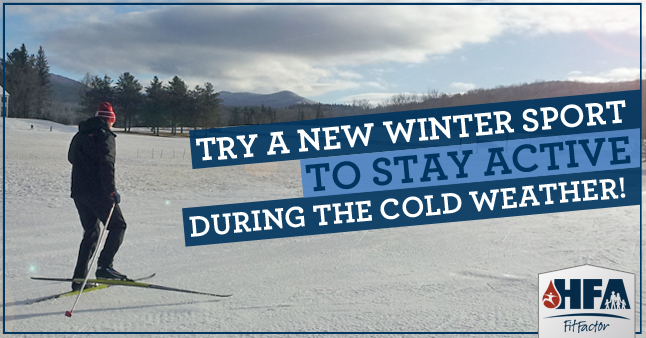
We all know that working out in the winter can feel like an impossible feat at times. However, once you start making it part of your regular routine, it’ll turn into a simple task and become easier to sustain through other parts of year when the weather isn’t so harsh. Keeping your body healthy and fit, particularly for those of us with bleeding disorders, is critical for our wellbeing on many levels. Therefore, it is important for us to stay focused, even when it’s icy cold outside.
The Center for Disease Control and Prevention (CDC) recommends that children get at least one hour of physical activity each day. For adults and older adults (with no limiting health issues), 150 minutes of moderate intensity aerobic exercise every week and muscle strengthening activities 2 days a week are the recommendations. 150 minutes each week sounds like a lot of time, but it’s not. That’s 2 hours and 30 minutes that can be spread throughout the entire week. Break it up into smaller chunks of time such as three, 10 minute intervals during the day. Be sure to keep the intensity moderate to vigorous to gain the most benefit from your activity.
Below are seven ideas for how you can stay active in these winter months – indoor and outdoor.
- If there is snow, enjoy it! Skiing, snowshoeing and sledding are all fun ways to get exercise in the winter – while enjoying the fresh air and beautiful scenery. Consider cross-country skiing. It is one of the most challenging aerobic activities out there and just like cycling, it’s easy on the body. Snowshoeing is also a great, low impact workout that you can do on any walking or hiking trail. The crisp air of winter and empty spaces can make for a calming and almost meditative experience.
- Join a recreational sports league. Leagues are a great way to schedule in a workout, have fun and be social at the same time. In most small cities, you can find a variety of sports leagues from basketball to indoor soccer to volleyball. Leagues follow a set schedule with games usually at the same time every week, so there is no room for procrastination or making excuses. Additionally, you are less likely to bail if you know you will be letting your teammates down. Guilt tripping works, and this time, it’s for your own good!
- Find some workout buddies. There must be at least one friend in your circle who is also looking for someone to workout with. Find an activity you both enjoy and use one another for motivation to stick to it! Mix it up by going hiking/snowshoeing on different trails in the area or swim laps together at the pool. Organize early morning boot camp -style trainings for a group of you.
- Take up a training class. Most gyms offer an array of fitness classes from yoga to Zumba to kettle ball to spinning – all of which result in great workouts. If gym classes aren’t your thing, consider doing it on your own by streaming the class right to your phone or tablet. New fitness apps offer a variety of ever-changing workout videos, which you can subscribe to for a monthly fee (between $5 and $30). On demand fitness programs give users complete control over when and where they exercise — and are significantly less expensive than the traditional health club.(2)
- Explore your local rec center. Many recreational centers have the equipment and space for a variety of free or low cost activities. Use your networks to organize pick-up games with a group of friends.
- Dance! For even more fun and less structure, crank up your new favorite songs and dance – either solo or with friends and family! There are innumerable playlists available online so you can mix it up between something fresh or “oldies” you haven’t heard in years.
- Lastly, keep on keepin’ on as if it were any other time of the year. Layer up, and continue doing your favorite activities no matter what the thermometer reads. Running, for instance, may be uncomfortable at first, but after a couple minutes you’ll be warmed up and might even find it invigorating. And because outdoor training requires extra exertion to raise your body temperature, you tend to burn more calories than indoor exercise.(1) When you finish, you’ll feel stronger for it – both physically and mentally!
Remember, safety first and always check with your physician or physical therapist prior to beginning any physical activity.
SOURCES
- https://www.washingtonpost.com/lifestyle/wellness/dont-be-afraid-of-the-cold-the-surprising-allure-and-benefits-of-an-outdoor-workout/2014/12/29/e9f01e66-8634-11e4-9534-f79a23c40e6c_story.html?utm_term=.5c9e550e7b9c
- http://www.wsj.com/articles/the-fitness-shift-that-should-worry-every-gym-owner-1485000002?tesla=y



